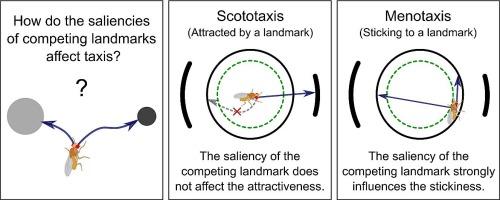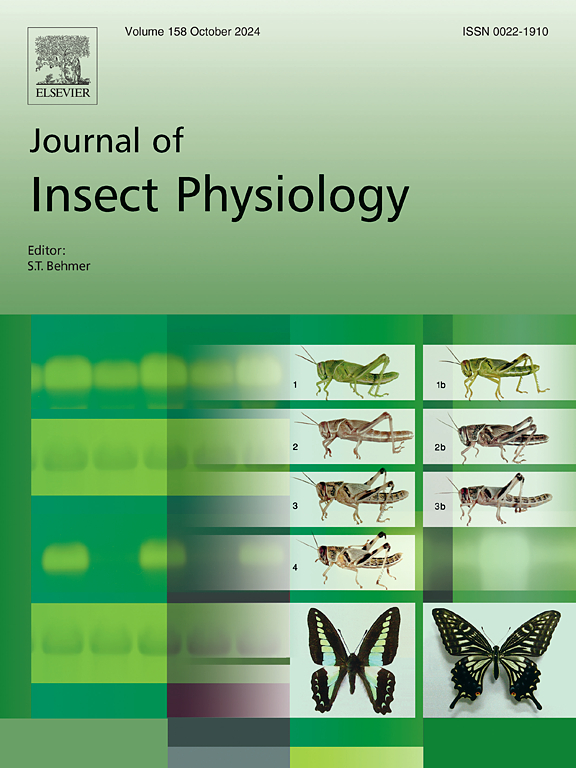Attractiveness versus stickiness: Behavioural preferences of Drosophila melanogaster with competing visual stimuli
IF 2.3
2区 农林科学
Q1 ENTOMOLOGY
引用次数: 0
Abstract
In nature, animals often encounter various competing stimuli and must make choices among them. Although the behaviour under two identical stimuli has been extensively studied for fruit flies, Drosophila melanogaster, how the appeal of one stimulus for the animals is influenced by the appeal of the other is not fully understood. In the present study, we systematically investigated this equation using a modified Buridan’s paradigm. We focused on the behaviour of fruit flies under asymmetric visual stimuli, i.e., two black stripes of different widths. We characterized two behaviour modes: (1) Attractiveness: moving toward a stripe in the inner area of the platform, and (2) Stickiness: staying around the edge near a stripe. Our results reveal that while Attractiveness of a stripe is primarily influenced by its own width and remains relatively independent of the opposite stripe, Stickiness is significantly affected by the width of the competing stripe. These findings suggest that the behavioural response of fruit flies to visual stimuli involves complex decision-making processes influenced by both intrinsic and extrinsic factors. This study provides new insights into the cognitive and sensory mechanisms underlying visual preference behaviour in Drosophila and highlights the importance of considering multiple stimuli in behavioural assays.

吸引力与粘性:黑腹果蝇对竞争性视觉刺激的行为偏好。
在自然界中,动物经常会遇到各种相互竞争的刺激,并必须在其中做出选择。虽然人们已经对果蝇在两种相同刺激下的行为进行了广泛的研究,但其中一种刺激对动物的吸引力如何受到另一种刺激的吸引力的影响,还没有完全搞清楚。在本研究中,我们使用改良的布里丹范式系统地研究了这一等式。我们重点研究了果蝇在不对称视觉刺激(即两条宽度不同的黑色条纹)下的行为。我们描述了两种行为模式:(1) 吸引力:向平台内侧区域的条纹移动;(2) 粘性:停留在条纹边缘附近。我们的研究结果表明,条纹的吸引力主要受其自身宽度的影响,相对独立于对面的条纹,而粘性则明显受竞争条纹宽度的影响。这些发现表明,果蝇对视觉刺激的行为反应涉及受内在和外在因素影响的复杂决策过程。这项研究为果蝇视觉偏好行为的认知和感觉机制提供了新的见解,并强调了在行为测定中考虑多种刺激的重要性。
本文章由计算机程序翻译,如有差异,请以英文原文为准。
求助全文
约1分钟内获得全文
求助全文
来源期刊

Journal of insect physiology
生物-昆虫学
CiteScore
4.50
自引率
4.50%
发文量
77
审稿时长
57 days
期刊介绍:
All aspects of insect physiology are published in this journal which will also accept papers on the physiology of other arthropods, if the referees consider the work to be of general interest. The coverage includes endocrinology (in relation to moulting, reproduction and metabolism), pheromones, neurobiology (cellular, integrative and developmental), physiological pharmacology, nutrition (food selection, digestion and absorption), homeostasis, excretion, reproduction and behaviour. Papers covering functional genomics and molecular approaches to physiological problems will also be included. Communications on structure and applied entomology can be published if the subject matter has an explicit bearing on the physiology of arthropods. Review articles and novel method papers are also welcomed.
 求助内容:
求助内容: 应助结果提醒方式:
应助结果提醒方式:


